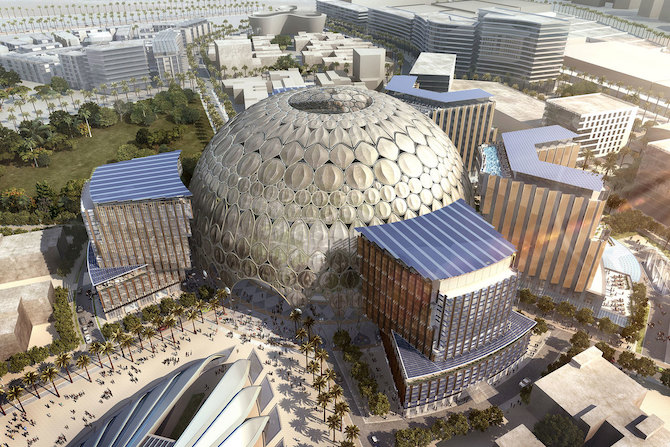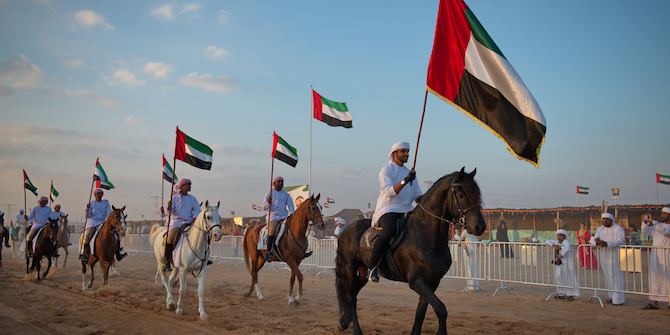by Robert Mogielnicki

A gold ring unearthed at Saruq al-Hadid, a 4,000-year-old archaeological site in Dubai’s desert, inspired the logo for the Dubai Expo 2020. The association of commercial activities from the Iron Age with a modern business event – clearly illustrated in this promotional video – reflects the crucial role of narrative building and mercantile heritage in Dubai. Indeed, the Al Maktoum ruling family plays a central role in an unfolding narrative that integrates state formation, affiliated economic institutions and historical tropes. Moreover, this grand mercantile narrative is interconnected to the spatial components of Dubai’s economic history and the emirate’s future economic strategies.
Expo 2020 is the world fair event originally planned to take place in Dubai from October 2020 until April 2021. However, the governing body overseeing the event agreed to delay the event by one year as a result of the global coronavirus outbreak. Officials in Dubai invited participants from all countries – including Israel, Iran and Qatar. More than 190 countries have confirmed their attendance. Event planners hope the event will function as a major revenue generator for Dubai and the broader United Arab Emirates (UAE).
Dubai is constructing a new urban space, District 2020, which will host the expo initially and then transform into an integrated residential community with business and retail outlets. The event will be the first world expo to take place in the Middle East, increasing the symbolic nature of the commercial fair. However, the symbolism is also being channelled in a distinctly local manner, and this localisation of the expo narrative begins with the Saruq al-Hadid archaeological site.
Saruq al-Hadid is an archaeological site that dates to the Iron Age and is located on Dubai’s border with Abu Dhabi. The ruler of Dubai, Sheikh Mohammed bin Rashid Al Maktoum, reportedly discovered the ancient settlement in 2002 while flying over the desert in his helicopter. Scientists subsequently unearthed around 12,000 artefacts, including gold jewellery, swords, daggers and other metal objects. The presence of goods and objects from current-day Lebanon, India and Afghanistan suggests that the site formed part of a broad overland trade network. An ornate and artistic gold ring proved one of the most exciting finds at the archaeological site.
A pro-government newspaper, The National, draws an explicit link between Saruq al-Hadid, Sheikh Mohammed and Expo 2020 in the following article from March 2016:
The elaborately fashioned gold ring, as Sheikh Mohammed remarked, served as evidence that ‘this land connected ancient civilisations’ long ago and symbolised that ‘we will continue to be a hub that connects the world’. The Expo 2020 logo, he said, ‘represents our message to the world that our civilisation has deep roots. We were and will always be a pot that gathers civilisations and a centre for innovation’.
The Saruq al-Hadid Archaeology Museum is located near the Dubai Creek in the Al Shindagha district of Dubai. The museum is housed in a converted, traditional wind tower building constructed in 1928 by Sheikh Juma bin Maktoum Al Maktoum, a son of the ruler of Dubai at the turn of the twentieth century. The decision to locate the museum along the Dubai Creek has a spatial significance: it implicitly reinforces the modern trading heritage of the emirate.
For much of the nineteenth and twentieth centuries, the neighbourhoods along the Dubai Creek served as the emirate’s bustling trading and commercial hubs. Emirati, Persian and South Asian traders conducted business and resided in these areas. However, changing technologies in commercial maritime vessels – namely the emergence of cargo ships requiring deep water ports – made the shallow, silted waters of the Dubai Creek less functional. Starting in the late 1970s, new commercial projects and development initiatives emerged farther south along the emirate’s coast, initiating a partial shift in the traditional centres of commercial and residential activity.
The emirate’s newer commercial hubs included the port and free zone developments at Jebel Ali – the emirate’s flagship commercial complex that will play a key role in Expo 2020. In fact, the purpose-built venue for the expo is named the Dubai World Trade Centre-Jebel Ali. Since the opening of its deep-water port, and the free zone in 1985, Jebel Ali has functioned as a primary facilitator of international firm activity and foreign direct investment in the emirate. New residential hubs, like the Dubai Marina, emerged in the early 2000s to augment the residential options in the southern part of the emirate.
Expo 2020 will take place within Dubai South, another southern-oriented urban development initiative launched by the government of Dubai in 2006 and based on the vision of Sheikh Mohammed. Dubai South integrates various components of a free zone concept and residential spaces to create ‘the preferred place to live, work and invest.’ District 2020, a dedicated urban space within Dubai South, will function as the physical and digital stage for Expo 2020. Officials plan to retain 80 percent of the expo’s built environment for the repurposing of the location. The Dubai South and District 2020 development schemes reflect a flexible and evolving mercantile heritage, able to adapt successful initiatives to match future needs.
Dubai’s mercantile heritage is increasingly becoming digital. On 4 January 2019, the ruler of Dubai clarified his vision for the future of Dubai through a 50-year charter. The ruler will ‘personally observe’ progress on these articles and tasked Dubai’s crown prince, Sheikh Hamdan bin Mohammed bin Rashid Al Maktoum, with the duty of overseeing the charter. This delegation of authority ensures that Al Maktoum family members will be at the forefront of the emirate’s future economic development, as well as the narrative creation that occurs in parallel. The forward-looking strategy focuses on transforming the emirate into a virtual commercial hub. Indeed, the Dubai government began issuing virtual business licenses this year, marking a new chapter in the creation of Dubai’s mercantile heritage.
This is part of a series emerging from a workshop on ‘Heritage and National Identity Construction in the Gulf’ held at LSE on 5–6 December 2019. Read the introduction here, and see the other pieces below.
In this series:
- Introduction by Courtney Freer
- Souvenir Sovereignty in Qatar by Suzi Mirgani
- Examining Kuwait National Museum by Sundus Alrashid
- Urban Planning and its Legacy in Kuwait by Alexandra Gomes
- Museums as Political Institutions of National Identity Reproduction: Are Gulf States an Exception? by İdil Akıncı
- The New Populist Nationalism in Saudi Arabia: Imagined Utopia by Royal Decree by Madawi Al-Rasheed
- Heritage and Sectarianism in Bahrain by Thomas Fibiger
- Managing UNESCO World Heritage Sites in Saudi Arabia: Contribution and Future Directions by Abdulelah Al-Tokhais
- Finding Mariam: the Invisible Woman in National Heritage Mythology by Alanoud Al-Sharekh
- Cultural Attendance: Attracting the Crowds to Museums in Saudi Arabia by Maha al-Senan
- Religion and Heritage in the Gulf: Significant in its Absence? by Courtney Freer
- Historical Archaeology in the Gulf by Robert Carter
- Militarised Nationalism in the Gulf Monarchies: Crafting the Heritage of Tomorrow by Eleonora Ardemagni
- The Practice of Heritage in the Northern United Arab Emirates by Matthew MacLean
- Displaying the Nation in Museum Exhibitions in Qatar by Alexandra Bounia
- Implicit and Explicit Cultural Policies in Qatar: Contemporary Art Production and Censorship by Serena Iervolino
- The UAE State ‘Rebirthing’ of Motherhood: Who is birthing who? by Rima Sabban






